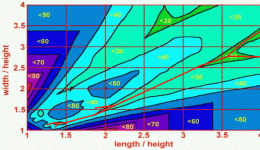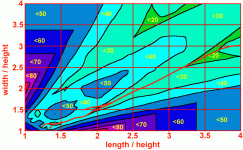Or the smallest dimension x 1.618 and then the smallest dimension x 2.618Try:
1. Find the cabinet volume
2. Find the volume's cube root. That's your 1.0 dimension.
3. Multiple the cube root by .618 and 1.618. Those are the other two dimensions.
Last edited:
Or the smallest dimension x 1.618 and then the smallest dimension x 2.618
Which is the same as smallest x phi = middle. Middle x phi = longest.
ie 1.618 ^2 = 2.618. Also 1/1.618 = 0.618
dave
Very "fun" ratio to play with. Probably the easiest method to remember though for the mathematically uninclined is the one I stated.Which is the same as smallest x phi = middle. Middle x phi = longest.
ie 1.618 ^2 = 2.618. Also 1/1.618 = 0.618
dave
Last edited:
Try:
1. Find the cabinet volume
2. Find the volume's cube root. That's your 1.0 dimension.
3. Multiple the cube root by .618 and 1.618. Those are the other two dimensions.
If he has a minimum dimension of 13.335 then wouldn't you?
1. 13.335 / .618 = 21.578
2. 21.578 * 1.618 = 34.913
21.578 (X3) = 10.047
If he has a minimum dimension of 13.335 then wouldn't you?
See post #4. We are starting to go in circles
dave
See post #4. We are starting to go in circles
dave
Yeah but you said 6, I said half a dozen
many golden ratios are possible in a speaker box
1. each individual surface
2. each individual surface in relation to other surfaces
3. cubic relations, volume, or volumes
4. mounting of each driver in relation to surface
5. relations between several drivers
6. bracing
I guess the list could be longer
1. each individual surface
2. each individual surface in relation to other surfaces
3. cubic relations, volume, or volumes
4. mounting of each driver in relation to surface
5. relations between several drivers
6. bracing
I guess the list could be longer
Hello,
Using Rayleigh formula , I simulated thousands of orthogonal parallelepipeds. I derived a graph summarizing the results.
Here it is.
The shapes (ratio length/heigh and ratio width / height) that lead to the best distributions (less audible resonances) are located on the red curve.
(Useful both to design enclosures or auditoriums)
The best dimensions of auditoriums given by Louden in his papers fall all of them on or nearby the red curve.
Ref :
Louden M.M., « Dimensions ratios of rectangular rooms with good
distribution of Eigentones » ; Acustica, 1971 ; Vol. 24 ; pp. 101-104
Best regards from Paris
Using Rayleigh formula , I simulated thousands of orthogonal parallelepipeds. I derived a graph summarizing the results.
Here it is.
The shapes (ratio length/heigh and ratio width / height) that lead to the best distributions (less audible resonances) are located on the red curve.
(Useful both to design enclosures or auditoriums)
The best dimensions of auditoriums given by Louden in his papers fall all of them on or nearby the red curve.
Ref :
Louden M.M., « Dimensions ratios of rectangular rooms with good
distribution of Eigentones » ; Acustica, 1971 ; Vol. 24 ; pp. 101-104
Best regards from Paris
Attachments
Thanks! Very interesting that the "curve" is not perfectly linear and changes based on the size of the room. F. Alton Everest also covers this subject in detail(With graphs) in his book. In fact, it could probably be inferred from this "curve" that something as small as a loudspeaker cabinet would require very different ratios than an actual room..
Hello Remlab,
Well, the graph is independant on the absolute dimensions.
(BTW : the criterion mapped here we want to minimize is the max interval of frequency between one resonance to the next and it is expressed on the graph in Hz x height )
Only the frequency of the resonances are changing but their relation, one to the next don't. So we can say it is quite universal and can be used either for a large auditorium eitner for a smalll enclosure.
Best regards from Paris, France
Jean-Michel Le Cléac'h
Well, the graph is independant on the absolute dimensions.
(BTW : the criterion mapped here we want to minimize is the max interval of frequency between one resonance to the next and it is expressed on the graph in Hz x height )
Only the frequency of the resonances are changing but their relation, one to the next don't. So we can say it is quite universal and can be used either for a large auditorium eitner for a smalll enclosure.
Best regards from Paris, France
Jean-Michel Le Cléac'h
The inside of a sphere has one very strong standing wave since all distances across the inside are the same. The outside is very nice.
dave
Doesn't really matter if the sphere is small enough that the magnet occupies the center, though. Plus since stuffing in the middle of a sphere would be at max velocity (where it's most effective) the inside of a sphere isn't necessarily a biggie. I'd want to be careful if the walls could "see" each other though.
Jean-Michel,
A very useful study. Thanx for posting.
Any chance you have a higher resolution graphic? (or even one in vector format?)
dave
hello Dave,
That one (see attached file) has a better resolution but the grid line and numbers doesn't have the color I wanted them to have.
Best regards from Paris, France
Jean-Michel Le Cléac'h
Attachments
Last edited:
I find it interesting that 1 x 1.5 x 2 is on the red line.
Hi,
That can't be good, as its very bad regarding coincidences of
room mode harmonics, e.g. 1(1st) = 2(2nd), 1
1.5(3rd) = 1(2nd) = 2(4th), etc.
I can't see how a good criteria would suggest the above.
rgds, sreten.
Plug it into a room mode calculator and observe. Not pretty..Hi,
That can't be good, as its very bad regarding coincidences of
room mode harmonics, e.g. 1(1st) = 2(2nd), 1=2(2n),
1.5(3rd) = 1(2nd) = 2(4th), etc.
I can't see how a good criteria would suggest the above.
rgds, sreten.
http://www.bobgolds.com/Mode/RoomModes.htm
The Bonello curve at the bottom of the page looks good though. Hmm..
Last edited:
- Status
- This old topic is closed. If you want to reopen this topic, contact a moderator using the "Report Post" button.
- Home
- Loudspeakers
- Multi-Way
- The Golden Ratio of 1.618

